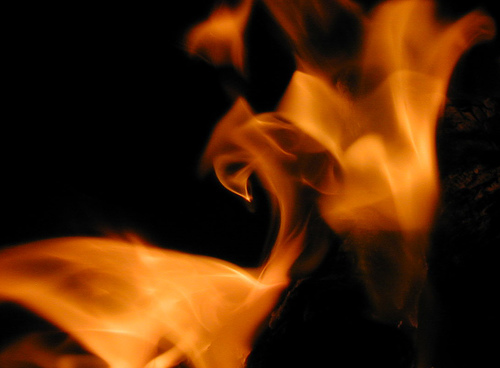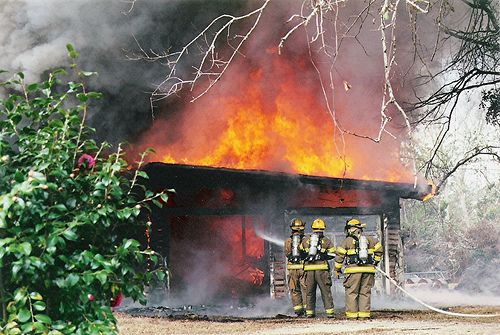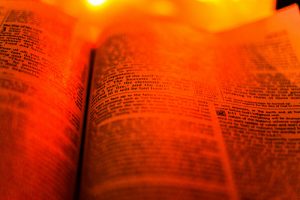Revised Common Lectionary Reflection, Proper 15, Year C
August 14, 2022*
Is not my word like fire, says the LORD, and like a hammer that breaks a rock in pieces? Jeremiah 23:29
I came to bring fire to the earth, and how I wish it were already kindled! Luke 12:49
I have complex feelings when it comes to fire. There’s nothing quite as wonderful as a good campfire with marshmallow s’mores in the making. A roaring fire in the fireplace on a crisp fall night is a true delight. The soft glow of candles at the Christmas Eve service evoke strong memories for me–both of the beloved hymn “Silent Night” and of the sickening smell of my small daughter’s singed bangs.
Fire is comforting. Fire is useful. Fire is beneficial. And, fire can be terrifying: whether it’s a mother watching her youngster’s bangs go up in smoke or witnessing the horrors of a house two doors down fully engulfed in flames or remembering the horrible tragedy of the 19 Granite Mountain Hotshots who died in 2013 when the Yarnell Hill fire in Arizona suddenly changed directions and trapped them. Fire is not to be taken lightly, especially when it comes to God.
In this week’s Lectionary readings, flames of faith ignite the hearts of the faithful, sustaining them in their trials while at the same time licking at the heels of a comfortable and easy gospel word. These are not pleasant passages to ponder and preach. The fire of God is bold and pure, and it seeks to burn away all that is useless, dead, and counterproductive.
When the fires of faith are fanned, someone in the vicinity is likely to get burned, and while probably a good thing, such purification is rarely embraced or welcomed. No one desires suffering, and very few of us enjoy being changed–whether such change is physical, chemical, emotional, or spiritual.
In thinking about preaching or teaching these lessons, one might begin by thinking about the nature of fire. Fire is, after all, a chemical reaction between oxygen (think ruach or Spirit breath) and some sort of fuel (think word of God). In order for this reaction to happen, heat must be present. There has to be a spark. Remember that old church camp song that started “It only takes a spark to get a fire going, and soon all those around will warm up to its glowing. That’s how it is with God’s love…”? Well, what if God’s love comes with purifying heat? What if God’s love comes to burn away all of one’s pretense and self-righteousness? Kind of loses its warm fuzzy feeling, doesn’t it?
God’s fire looks less like the ever-present gentle eternal flame of the sanctuary candle and more like a wildfire that switches direction and threatens to consume our very beings. Jesus was under fire in the reading from Luke’s gospel. Pressures were mounting. He was on his way to Jerusalem, and he needed people to understand that his purpose was to change things–to change the form of matter and to burn away all that does not matter. The words are provocative. They do not flow like sweet honey but rather burn and sear and break us open. In doing so, the fire and word of faith will make of us something new, much like a controlled burn on the open prairie eradicates the weeds that threaten to choke next season’s tender wheat.
So, fellow bearer of this dangerous and renewing, this wild and wonderful word of life, are you ready to get burned? Are you ready to unleash the gospel flames and fan them? Even if you approach this week’s lessons with fear and trepidation, remember that you are not alone. You stand under the cover of a great cloud of witnesses and in the shadow of the cross. You’re already aflame; where God is present there is nothing to lose and eternity to gain. Blessings on your preaching and teaching.
In Worship
How about including a series of “Weather Reports” in your worship this morning? You might even want to start a series that will continue periodically throughout the church year. Check out Kathleen Norris’ lovely book Dakota: A Spiritual Geography for examples. Consider reporting (in weather report format and imagery) the climate of your community, your congregation, your own faith life, the news of the week, and so forth. You might even be able to craft a sermon around such “reporting” and observation using the gospel lesson for this week.
With Youth
Martyrs? Today? Really?
Yes! In North America we don’t face very many real dangers as a result of our faith. The worst of it is probably being laughed at for pursuing something non-rational and fanciful or simply being ignored and discounted. Rare is the occasion where someone is beaten or killed as a result of his or her faith in Jesus Christ. This is not the case in other parts of the world. Christians die every day as a result of their faith. If you have a copy of Foxe’s Book of Martyrs, give a couple of examples from it (a free Kindle copy is available). Click here for an article from America: The National Catholic Review or visit the Voice of the Martyrs website for more recent examples of modern-day martyrs. Westminster Abbey now features statues of 10 modern martyrs above the restored western doorway. To check out the statues and stories click here.
Considering the stirring words of the epistle lesson from Hebrews about the great cloud of witnesses, how are we who live in safety, freedom to live as followers of Christ? What do we have to lose? How can we be bolder in our discipleship? What can we do to support others who willingly put themselves in harm’s way (missionaries, for example)?
With Children
Wheat or Straw? What’s the Difference?
If you live in a farming community you may be able to get the real deal for this illustration. If not, you’ll find plenty of images using Google or Flickr. Ask children if they can tell the difference between hay and straw. Ask them why this is even important? Again, in a farming community some children will be able to tell you quite clearly what the difference is between the two and why this is important. Click here and here for explanations and images that show the difference.
Next show the children a jar that contains some fine bread flour. Ask them whether the jar contains wheat or straw. Show the children a beautiful loaf of artisan bread. Ask them whether the loaf was made from wheat or straw.
This week’s Old Testament reading from Jeremiah asks “What has straw in common with wheat,” says the LORD. Well, the answer has to do with how it is used. Wheat has real value to feed and give life. Straw is used mostly for animal bedding, and the stubble is often burned away once the straw is cut. The contrast is that God’s word is like the finest wheat–feeding us and giving life.
*This reflection was first published in 2013.
Here are Pastor Blezard’s other reflections for Proper 15, Year C:
2016 – Controlled Burns & Faithful Forecasting
2019 – Calling all us hypocrites
Photos: Matthew Venn, Loco Steve, and Key Foster, Creative Commons. Thanks!






Leave a Reply